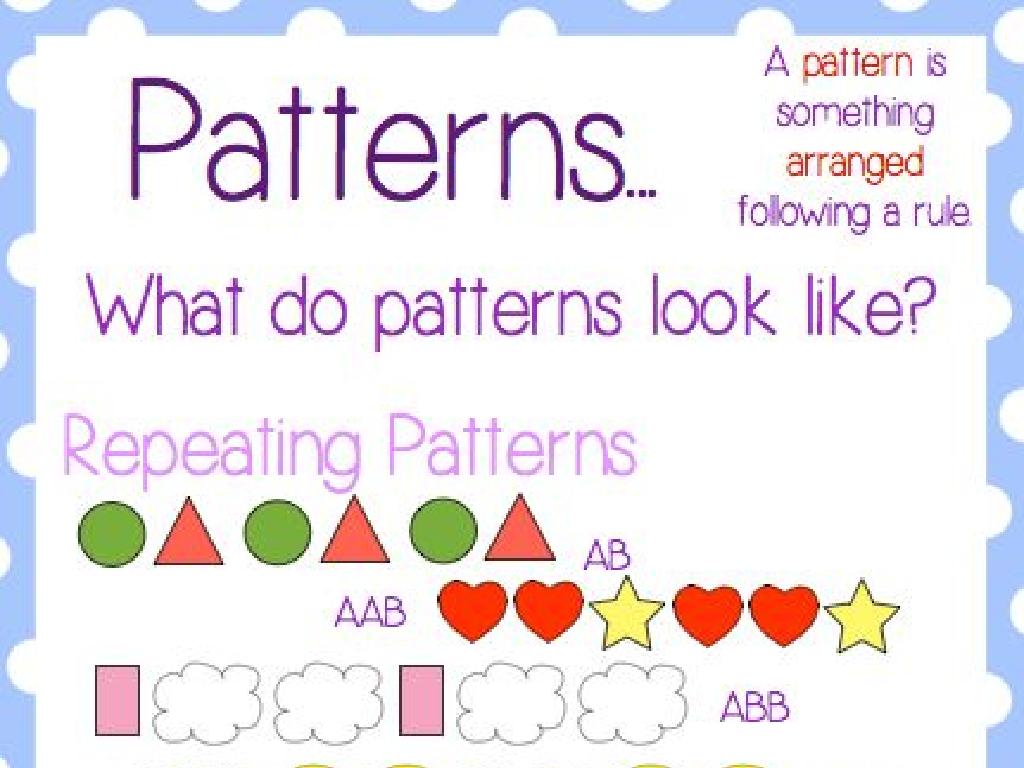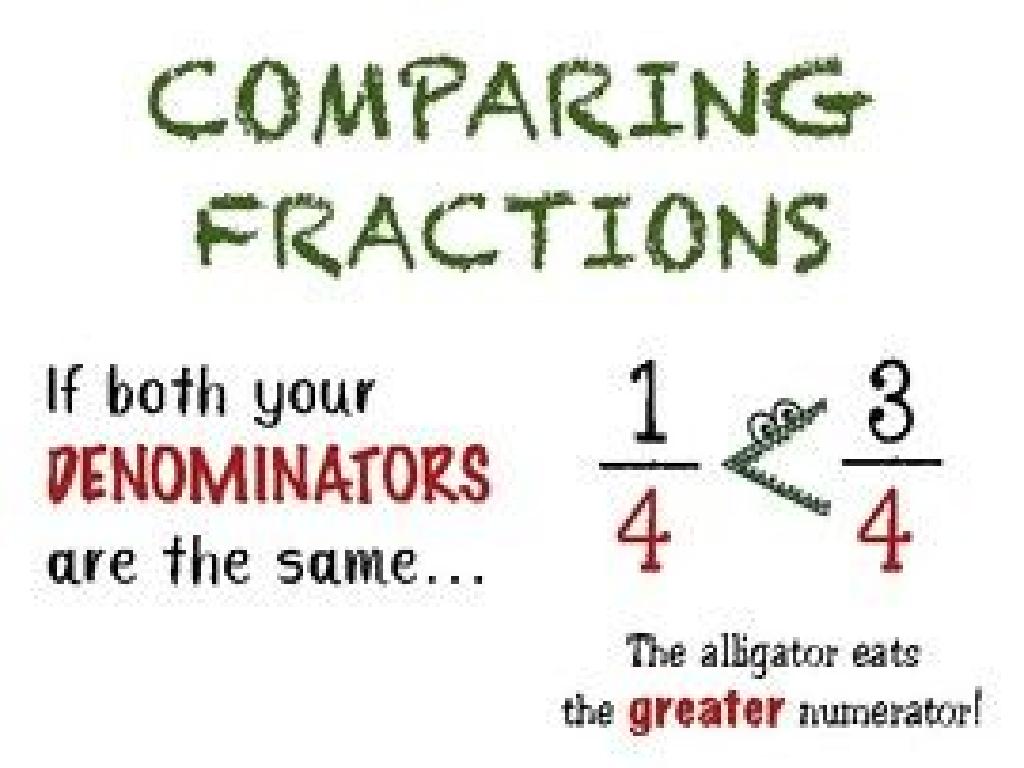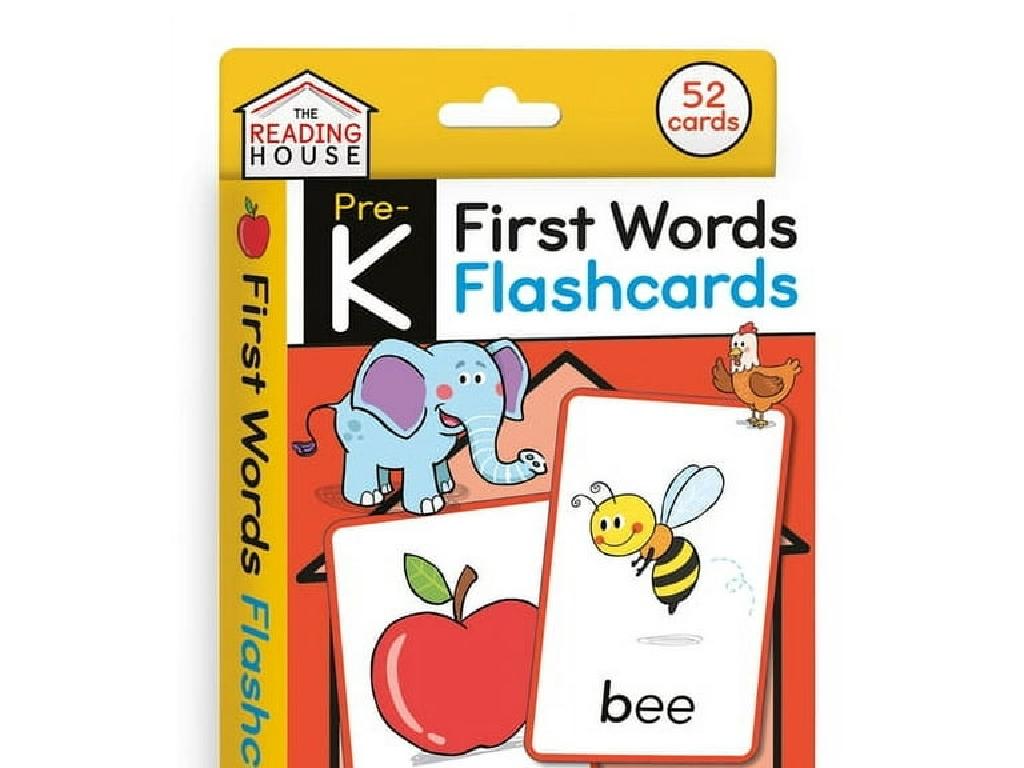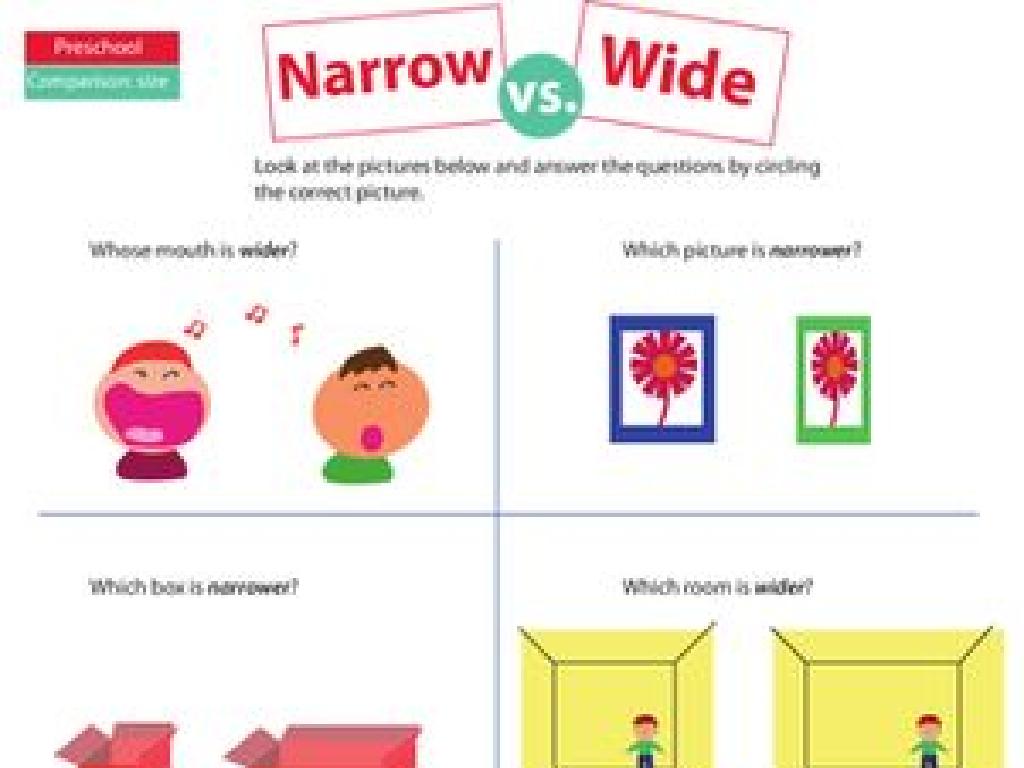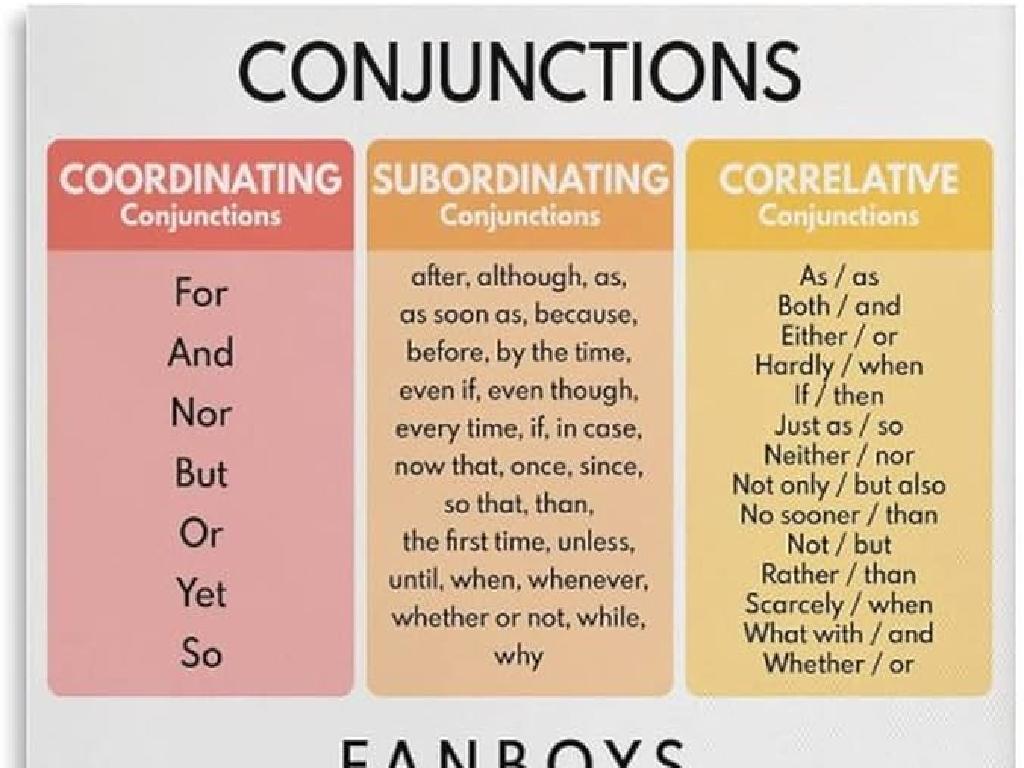Subtract Fractions With Like Denominators Using Number Lines
Subject: Math
Grade: Fourth grade
Topic: Understand Fraction Addition And Subtraction
Please LOG IN to download the presentation. Access is available to registered users only.
View More Content
Subtracting Fractions with Like Denominators
– Recap: What are fractions?
– Fractions represent parts of a whole, like a slice of pizza.
– Like denominators explained
– Like denominators mean the bottom numbers in fractions are the same.
– Subtracting fractions on a number line
– To subtract, move left on the number line for each part subtracted.
– Practice with examples
– Example: 3/4 – 1/4. Start at 3/4, move left 1/4 to land on 2/4.
|
Begin with a brief review of fractions to ensure students recall that fractions represent parts of a whole. Clarify the concept of like denominators, emphasizing that they are the same in the fractions being subtracted. Introduce the number line as a visual tool to help students understand subtraction of fractions by showing how to move left on the line to subtract. Provide clear examples, such as subtracting 1/4 from 3/4, and demonstrate this on a number line. Encourage students to visualize the process and practice with additional examples to solidify their understanding.
Understanding Like Denominators
– Denominators show equal parts
– Like denominators are the same
– Examples: 1/4 and 3/4, 5/8 and 7/8
– Both fractions are parts of 4 or 8
– Subtracting with like denominators
– Use a number line to show subtraction
|
This slide introduces the concept of like denominators as a foundation for understanding how to subtract fractions. Denominators are a key part of fractions, indicating into how many equal parts something is divided. When the denominators are the same, we call them ‘like denominators.’ Provide clear examples such as 1/4 and 3/4, or 5/8 and 7/8, to illustrate this concept. Emphasize that having like denominators simplifies the process of subtracting fractions, as students only need to subtract the numerators while keeping the denominator the same. Demonstrate this subtraction using a number line to visually represent the fractions and the act of subtracting one from the other, which can help solidify the concept for visual learners.
Visualizing Fractions on a Number Line
– Number lines show fraction values
– A number line can help us understand where fractions fit in relation to whole numbers.
– Mark like denominators on a line
– Place fractions with the same bottom number (denominator) on the number line to compare them.
– Measure distance between fractions
– The space between fractions on the number line represents the difference in their values.
– Subtract fractions using a number line
– To subtract, find the positions of the fractions and see how many spaces they are apart.
|
This slide introduces the concept of using a number line to visualize and understand fractions, which is a foundational skill in fourth-grade mathematics. By marking fractions with like denominators on a number line, students can easily compare their sizes and see the distance between them. This visual representation helps students grasp the concept of subtracting fractions by simply ‘jumping back’ on the number line to find the difference. Encourage students to practice by marking various fractions on a number line and finding the distances between them. This will solidify their understanding of fraction subtraction and prepare them for more complex operations with fractions.
Subtracting Fractions on a Number Line
– Subtraction finds the difference
– Steps to subtract on a number line
– Mark the fractions on the line, jump back to subtract
– Example: 3/4 – 1/4
– Start at 3/4, jump back 1/4, land on 1/2
– Practice with different fractions
– Try subtracting 2/4 from 3/4 or 1/3 from 2/3
|
This slide introduces the concept of subtracting fractions with like denominators using a number line, which is a visual method that helps students understand the process of subtraction. Begin by explaining that subtraction is the operation of finding the difference between two numbers. Demonstrate on a number line by marking the fractions and showing how to ‘jump back’ to find the answer. Use the example of subtracting 1/4 from 3/4 to show that you start at 3/4 on the number line, move back 1/4, and end up at 1/2. Encourage students to practice with different fractions to solidify their understanding. Provide several number lines for students to use during practice and ensure they understand that the denominators must be the same to use this method.
Let’s Practice Together: Subtracting Fractions
– Class Activity: Subtract 2/6 from 5/6
– Work in pairs on number lines
– Use a number line to visualize subtracting fractions
– Find the difference between the fractions
– Mark 5/6, then count back 2/6 to find the answer
– Share your results with the class
|
This slide introduces a collaborative class activity focused on subtracting fractions with like denominators using number lines. Students will pair up to reinforce their understanding of the concept through hands-on practice. Provide each pair with a number line, and guide them to mark the starting fraction (5/6) and subtract the second fraction (2/6) by counting backwards. Emphasize the importance of visual representation in comprehending subtraction of fractions. After completing the activity, facilitate a discussion where pairs share their findings, fostering a collaborative learning environment. Possible variations for different pairs could include subtracting different fractions with like denominators, such as 3/4 – 1/4 or 5/8 – 3/8, to ensure a diverse range of examples.
Subtracting Fractions in Real Life
– Fractions in daily life
– Fractions are part of our everyday experiences, like sharing food.
– Pizza slice example
– If you eat 2 out of 6 slices, you have 4/6 slices left.
– Subtracting on a number line
– Imagine each pizza slice as a section on the number line.
– Understanding what’s left
– After eating 2 slices, see how many sections you move back on the line.
|
This slide aims to help students apply their understanding of fractions to real-life situations, making the concept more relatable and easier to grasp. Use the example of a pizza divided into equal slices to illustrate how fractions work. Show how eating 2 out of 6 slices means subtracting 2/6 from the whole, leaving 4/6. Use a number line to visually represent the pizza slices and demonstrate the subtraction process. This will help students visualize the concept of ‘taking away’ parts of a whole. Encourage students to think of other examples where they might use fraction subtraction in their daily lives.
Class Activity: Fraction Action Game!
– Play ‘Fraction Action’ with a partner
– Use the game board to subtract fractions
– Each space on the board represents a fraction subtraction problem
– First to finish with correct answers wins!
– Check each other’s work to ensure the answers are correct
– Have fun while learning fraction subtraction
|
This interactive game is designed to help students practice subtracting fractions with like denominators in a fun and engaging way. Set up the classroom with game boards and pair up the students. Each pair will take turns to solve fraction subtraction problems represented by spaces on the board. They will use number lines to visualize the subtraction process. The first pair to reach the end of the board with all correct answers wins the game. As a teacher, circulate around the room to assist and check answers. Possible variations of the game could include timed challenges, obstacle spaces that require solving additional problems, or bonus spaces that allow a team to move extra spaces for particularly difficult questions.
Wrapping Up: Subtracting Fractions
– Excellent work on fraction subtraction!
– Homework: Fraction worksheet completion
– Finish the provided worksheet on subtracting fractions with like denominators.
– Use number lines for practice
– Remember to draw number lines to help find the answers.
– Keep practicing at home!
|
Today’s lesson focused on understanding how to subtract fractions with like denominators using number lines. For homework, students are assigned a worksheet to reinforce what they’ve learned. Remind them to use number lines as a visual aid to help them see the subtraction process. Encourage them to practice regularly at home to build confidence and proficiency in this skill. In the next class, we will review the homework and address any questions or difficulties the students may have encountered.

